Top 20 wonders of the underwater world
From barrier reefs and blue holes to seabed sculpture parks, we don our wet suits and explore 20 of the best underwater attractions.
1) Great Barrier Reef, Australia
The world’s largest coral reef system, the Great Barrier Reef, is a UNESCO World Heritage Site.
This 1,400m (2,300km) reef, which can be seen from outer space, remains one of the seven natural wonders of the world. Its kaleidoscopic coral shelves are home to an abundance of marine life including turtles, sharks and more than 1,500 species of fish.
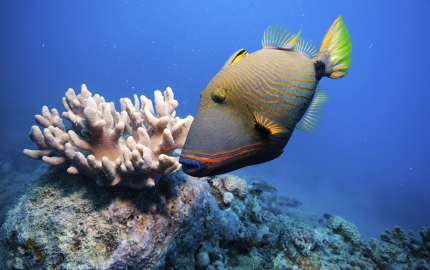 An orange-lined triggerfish surveys the Great Barrier Reef
An orange-lined triggerfish surveys the Great Barrier Reeftreetstreet / Thinkstock
2) Underwater Sculpture Park, Grenada
Imbued with beautiful beryl blues, Grenada’s dazzling west coast becomes all the more spectacular when you dip below the waves and discover its sunken art museum.
The Underwater Sculpture Park, featuring installations by Jason deCaires Taylor and Troy Lewis, is located on the seabed and is the first of its kind. Man on a Bike, a life-size gent cycling along a reef, and Ring of Children, a circle of kids holding hands, are among the inspiring artworks that double up as a substrate for marine life.
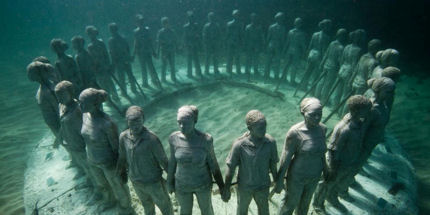 Ring of Children is just one of a host of seabed sculptures
Ring of Children is just one of a host of seabed sculpturesGrenada Underwater Sculpture Park
3) Underwater Museum, Mexico
When hurricanes and tropical storms destroyed reefs in Cancun, Mexico, authorities floated the idea of submerging 500 life-size sculptures onto the seabed to give marine life something to live upon.
In dived British artist Jason deCaires Taylor, who created an incredible set of statues that range from sunken cars and small houses to bankers burying their heads in the sand. Spread over two sites, both can be reached by snorkelers.
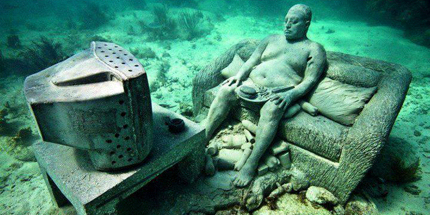 The Underwater Museum doubles up as a substrate
The Underwater Museum doubles up as a substrateCreative Commons / 2il org
4) Belize Barrier Reef, Belize
Charles Darwin described it as “the most remarkable reef in the West Indies,” a statement that still rings true today. Forming part of the Mesoamerican Barrier Reef, this underwater World Heritage Site is home to a cornucopia of marine life, including 500 species of fish and 106 species of coral.
The jewel in its crown, though, is the Great Blue Hole, a large submarine sinkhole that attracts divers and snorkelers from around the world.
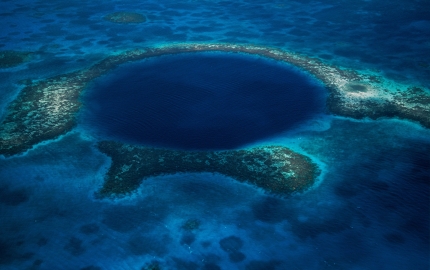 The Great Blue Hole is a feature of the Belize Barrier Reef
The Great Blue Hole is a feature of the Belize Barrier ReefPurestock / Thinkstock
5) S S Thistlegorm, Egypt
Sunk by German bombers in 1941, the trains, trucks, armoured vehicles and motorcycles aboard S S Thistlegorm never made it to their intended destination of Alexandra in Egypt.
Instead the vessel was considered lost until local fishermen helped French explorer Jacques-Yves Cousteau pinpoint its remains near Ras Muhammad in the Red Sea in the 1950s. Now divers can discover the entire ship, including anti-aircraft machine guns and holes left by the bombs, in a single dive.
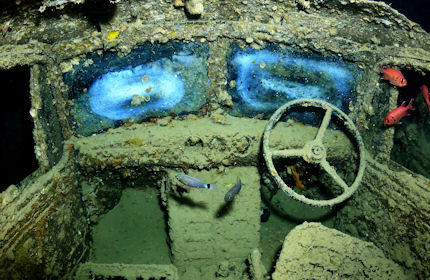 Fish explore a truck on the sunken S S Thistlegorm
Fish explore a truck on the sunken S S ThistlegormCreative Commons / Wilfred Hdez
6) Galapagos Islands, Ecuador
A miracle of Mother Nature, the Galapagos Islands are home to some of the most diverse marine life on the planet. The archipelago’s unique flora and fauna – Galapagos penguins, Galapagos sharks, marine iguanas and many more – have evolved in isolation from the rest of the world, inspiring Charles Darwin to develop his theory of evolution there.
For whales and sharks, the best time to visit is between June and September.
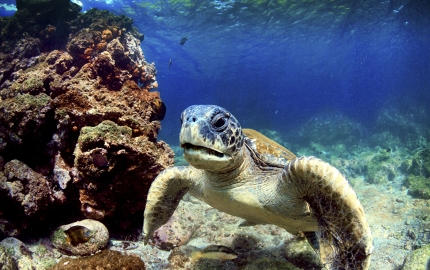 Green turtles are part of an all star line-up in Galapagos
Green turtles are part of an all star line-up in Galapagospkphotoscom / Thinkstock
7) Blue Corner Wall, Palau
With an astounding array of underwater life (think bright sea whips, darting reef sharks, flapping eagle rays, rich coral reefs and schools of pelagic fish), Blue Corner Wall is considered by many as the best dive site in the world.
Just south of the Philippines, this underwater marvel in Palau isn’t for the inexperienced. Strong currents can drag even the strongest swimmer away, so nearly all divers hook themselves into the wall before taking in one of the most breathtaking, below the surface sights known to man.
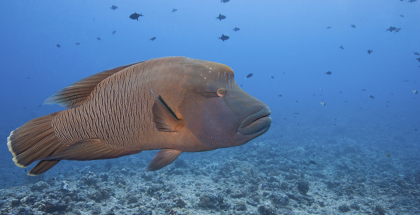 Abundant marine life makes Blue Corner Wall a joy to dive
Abundant marine life makes Blue Corner Wall a joy to diveMichael Stubblefield / Thinkstock
8) Ithaa Restaurant, Maldives
If you’re looking for a seafood restaurant with a difference, Ithaa might be for you. This underwater eatery in the Maldives turns the aquarium theme on its head, exhibiting diners to the local marine life in a transparent dining room.
The first of its kind, Ithaa seats just 14 guests at a time, who can quaff their way through a six-course seafood dinner in full view of nosy – and, presumably, disapproving – fish.
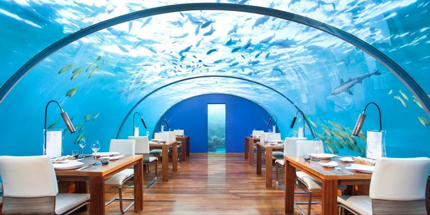 Ithaa Restaurant turns the aquarium theme on its head
Ithaa Restaurant turns the aquarium theme on its head Conrad Maldives Rangali Island
9) Lake Baikal, Russia
The oldest and deepest (1,700m/5,577ft) freshwater lake in the world, Lake Baikal is home to 20% of the planet’s unfrozen freshwater.
Located in southeast Siberia, its unique freshwater fauna, which includes the famous freshwater seal, has evolved in isolation from the rest of the world, which is why some call it ‘the Galapagos of Russia.’ During winter it is possible to drive across the lake.
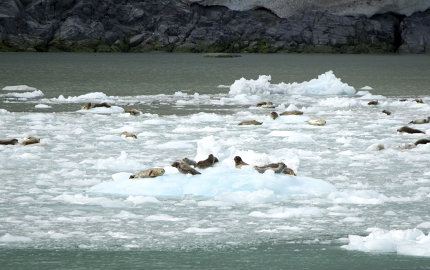 Baikal seals are unique to this lake in Siberia
Baikal seals are unique to this lake in Siberiajim8080 / Thinkstock
10) Beluga whales, Canada
Every year, between June and August, thousands of beluga whales swim to the shores of Churchill to frolic in the recently melted waters.
Known as ‘sea canaries,’ on account of the strange chirping noises they make, these white whales are a friendly bunch and have become something of a tourist attraction in the Hudson Bay, where they swim with snorkelers and kayakers.
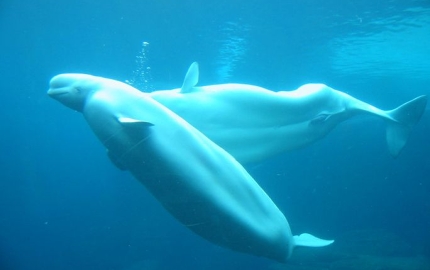 Beluga whales frolic in the icy waters of Hudson Bay
Beluga whales frolic in the icy waters of Hudson BayKwok Chan / Thinkstock
11) Gulf of Aqaba, Jordan
Most divers come to Jordan’s Red Sea for its gentle currents, warm waters and colourful coral reefs. But disaster junkies and history buffs arrive in search of something different – sunken military hardware.
An important WWII supply route, these troubled waters saw many ships sink during the conflict. Popular wrecks include the scuttled Cedar Pride and an M40 tank, which sits silently on the seabed.
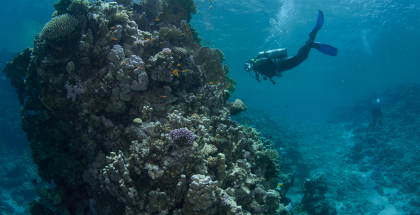 A diver explores the Gulf of Aqaba's warm waters
A diver explores the Gulf of Aqaba's warm waters Jonathan Milnes / Thinkstock
12) Jules Undersea Lodge, USA
Airport transfers take on a new level of difficulty for guests of Jules Undersea Lodge in Key Largo. Nestled in a mangrove lagoon, some 6.5m (21ft) underwater, this former research laboratory can only be reached by experienced scuba divers.
Rooms are a tad poky, but guests have the use of showers and a kitchen – a pizza delivery service is also available. If Florida’s marine life isn’t entertaining enough for you, the hotel has a decent collection of film, literature and music.
13) The annual coral spawn, throughout the tropics
Swimming through masses of, what is essentially, coral sperm may not sound like everyone’s idea of fun, but every autumn divers and snorkelers swarm to reefs to witness the annual spawn.
Despite sounding unpleasant, the rare natural spectacle is an incredibly beautiful event, with the coral’s newly released gametes resembling something of an underwater snowstorm as they float toward the surface.
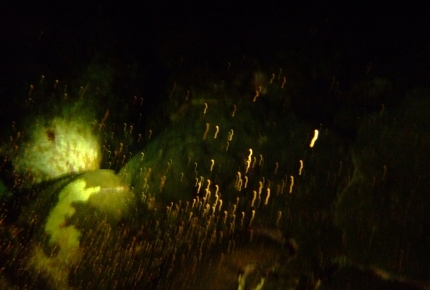 Coral spawn glistens in the light of a torch
Coral spawn glistens in the light of a torchCreative Commons / Brittanie
14) Florida shark migration, USA
For those suffering with galeophobia (a fear of sharks) news that the largest shark migration in the US happens off the coast of Florida every year may be enough to put them off visiting The Sunshine State.
But for shark and wildlife lovers the winter migration grants a rare opportunity to witness tens of thousands of blacktip sharks up close as the predators make their way south along the Atlantic coast.
Still not convinced? Well, let this reassure you; not one fatal blacktip shark attack has been recorded in Florida since records began.
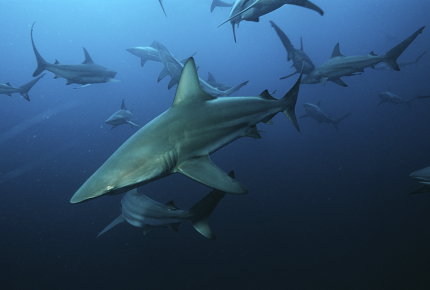 The migration means onlookers can see timid blacktips up close
The migration means onlookers can see timid blacktips up closeIPG Gutenberg UK LTD / Thinkstock
15) Sandfalls, Mexico
This kind of phenomenon seems more suited to a trippy fantasy film than the coast of Cabo in Mexico. The sandfalls are a twist on your traditional waterfall, with strong currents causing sand to slip from underwater coastal shelves down into a deep 120m (400ft) abyss.
Cabo’s sandfalls were originally discovered by the famous diver, Jacques Cousteau, and are home to over 300 species of marine life including barracuda, reef sharks and octopus.
16) Lost city of Heracleion, Egypt
The ancient Egyptian port of Heracleion, founded in 8 BC, disappeared under the waves some 1,200 years ago and its existence had long since descended into myth until it was rediscovered in 2000 by archaeologist Frank Goddio.
The underwater city now lies 6.5km (4 miles) off the coast of Aboukir Bay near Alexandria, where archaeologists have discovered the remains of giant religious statues, ancient ships and, most intriguingly, dozens of small limestone sarcophagi believed to have once contained mummified animals.
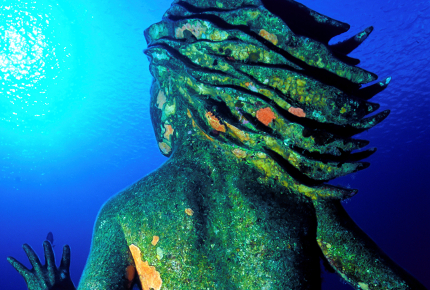 16-foot stone statues guard the underwater city of Heracleion
16-foot stone statues guard the underwater city of HeracleionGlobal_Pics / Thinkstock
17) Yonaguni monument, Japan
Several intriguing rock formations off the Japanese island of Yonaguni have mystified scholars since their discovery in 1987.
Debate rages over whether these structures, which look like some sort of underwater temple, are man-made or a quirk of nature. Some experts, including Masaaki Kimura, have gone one step further, suggesting the formations are ruins of the lost city of Mu.
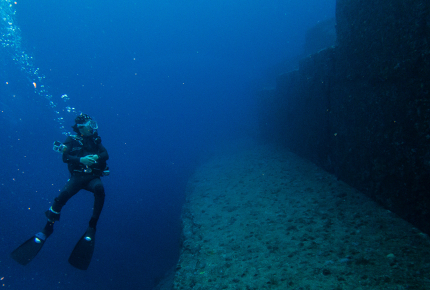 A diver weighs up the Yonaguni Monument
A diver weighs up the Yonaguni MonumentCreative Commons / Vincent Lou
18) Neptune Memorial Reef, USA
The largest man-made reef ever created, Neptune Memorial in Florida was built as an underwater burial site, where people could have their cremated remains mixed with cement to help create an artificial reef.
However, after a souring of relationships between the creators and the sponsor, the submarine cemetery has been abandoned. Since then nature has reclaimed the site, which is now officially identified as a natural coral reef – albeit one made from dead people.
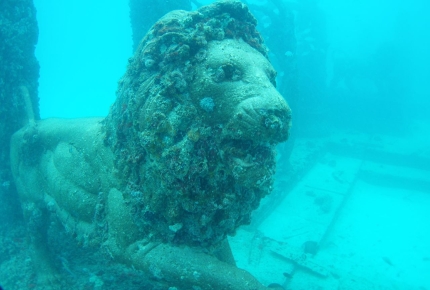 The reef is made from concrete infused with cremated remains
The reef is made from concrete infused with cremated remainsCreative Commons / Todd Murray
19) Underwater post office, Vanuatu
A gimmick that generated much media coverage when it opened, this underwater post office is located off the coast of Hideaway Island in Vanuatu – predictably, it is the only one of its kind.
Travellers can don full dive gear or a snorkel and fins to post their waterproof postcards, either at the post box or the manned counter. Admittedly, it does look kind of fun.
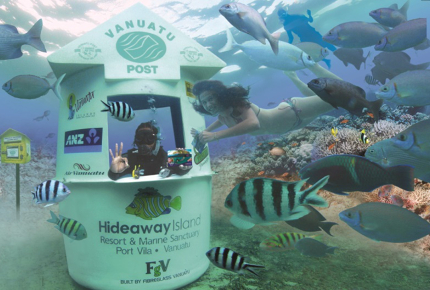 The world's most impractical post office is also the most fun
The world's most impractical post office is also the most funPADI
20) The Sardine Run, South Africa
Known as ‘the great underwater migration,’ the spectacular sardine run sees billions of sardines head north along the eastern coast of South Africa every summer.
The sardine shoals, which stretch up to 15km (9 miles) in length, are the star attraction, but dolphins, sharks and seabirds come to spoil the show by feasting on the fish.
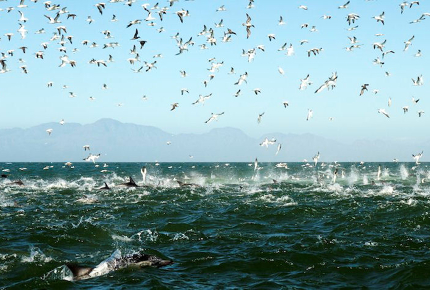 The sardine run is a spectacle both above and below water
The sardine run is a spectacle both above and below waterCreative Commons / Angela Huxham
Related articles
The 20 islands you never knew existed
The 20 best beaches in Britain
Do you have any Feedback about this page?
© 2025 Columbus Travel Media Ltd. All rights reserved. No part of this site may be reproduced without our written permission, click here for information on Columbus Content Solutions.









 You know where
You know where